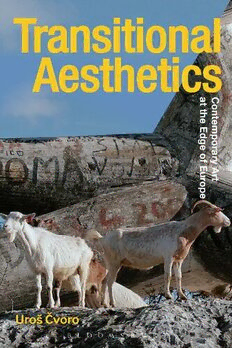Table Of ContentTransitional Aesthetics
Transitional Aesthetics
Also available from Bloomsbury
Radical Aesthetics – Radical Art
Series editors: Jane Tormey and Gillian Whiteley
(Loughborough University, UK)
Promoting debate, confronting conventions and formulating alternative
ways of thinking, Jane Tormey and Gillian Whiteley explore what radical
aesthetics might mean in the twenty-first century.This new books series,
Radical Aesthetics – Radical Art (RaRa), reconsiders the relationship between
how art is practised and how art is theorized. Striving to liberate theories of
aesthetics from visual traditions, this series of single-authored titles expands
the parameters of art and aesthetics in a creative and meaningful way.
Encompassing the multisensory, collaborative, participatory and transitory
practices that have developed over the last twenty years, Radical Aesthetics
–Radical Art is an innovative and revolutionary take on the intersection
between theory and practice.
Published and forthcoming in the series:
Practical Aesthetics: Events, Affects and Art after 9/11, Jill Bennett
Working Aesthetics: Labour, Art and Capitalism, Danielle Child
Eco-Aesthetics: Art, Literature and Architecture in a Period of
Climate Change, Malcolm Miles
Civic Aesthetics: Militarism in Israeli Art and Visual Culture, Noa Roei
Counter-Memorial Aesthetics: Refugees, Contemporary Art and the
Politics of Memory, Veronica Tello
For further information or enquiries please contact RaRa series editors:
Jane Tormey: [email protected]
Gillian Whiteley: [email protected]
Transitional Aesthetics:
Contemporary Art at the
Edge of Europe
Uroš Čvoro
BLOOMSBURY ACADEMIC
Bloomsbury Publishing Plc
50 Bedford Square, London, WC1B 3DP, UK
BLOOMSBURY, BLOOMSBURY ACADEMIC and the Diana logo are trademarks of
Bloomsbury Publishing Plc
First published in Great Britain 2018
Copyright © Uroš Cˇvoro, 2018
Uroš Cˇvoro has asserted her right under the Copyright, Designs and Patents
Act, 1988, to be identified as Author of this work.
Cover design: …
Cover image © …
All rights reserved. No part of this publication may be reproduced or transmitted
in any form or by any means, electronic or mechanical, including photocopying,
recording, or any information storage or retrieval system, without prior permission
in writing from the publishers.
Bloomsbury Publishing Plc does not have any control over, or responsibility for,
any third-party websites referred to or in this book. All internet addresses given
in this book were correct at the time of going to press. The author and publisher
regret any inconvenience caused if addresses have changed or sites have ceased
to exist, but can accept no responsibility for any such changes.
A catalogue record for this book is available from the British Library.
A catalog record is available from the Library of Congress.
ISBN: HB: 978-1-3500-5341-0
ePDF: 978-1-3500-5340-3
eBook: 978-1-3500-5343-4
Series: Radical Aesthetics – Radical Art
Typeset by Deanta Global Publishing Services, Chennai, India
To find out more about our authors and books visit www.bloomsbury.com
and sign up for our newsletters.
For all Yugoslavs, anytime and anyplace
vi
Contents
Acknowledgements viii
Preface ix
List of Illustrations x
Introduction: In Transition 1
1 The Politics of Transitional Aesthetics 15
2 ‘We Came to Take Your Jobs Away’: Migration and Agency in the
Work of Tanja Ostojić and Angela Melitopoulos 37
3 Going Too Far: Translation and Over-Identification as a Critique
of Transition 61
4 Halfway Tradition 85
5 The Afterlife of Abandoned Monuments 107
6 Transitional Archives: Art and Historical Memory in
Former Yugoslavia 129
Afterword: Beyond Transitional Aesthetics 151
Bibliography 157
Index 170
Acknowledgements
The research and writing of this book were supported by Faculty Research
Grants from UNSW Art & Design in 2016 and 2017. Thank you to friends
who generously lent their time and considerable brainpower to make this
book better: Verónica Tello, Chrysi Lionis, Astrid Lorange. My thanks to
Anna Munster for her mentorship, and Marie Sierra and Ross Harley for
their support. I am grateful to artists who shared and discussed their work:
Marta Popivoda, Angela Melitopoulos, Tanja Ostojić, Igor Grubić, Mladen
Miljanović, Vladimir Nikolić, Zoran Todorović, David Maljković.
Also, thank you to Frankie Mace at Bloomsbury, the editors of RaRa
book series Gillian Whiteley and Jane Tormey, and Elena Knox at Rhubarb.
Parts of this book have been published in earlier form: Chapter 6 appeared
in Continuum, parts of Chapter 4 in Družboslovne Razsprave and parts of
Chapter 2 in edited collection Europe Unfinished. My thanks to the editors and
anonymous peer-reviewers for their feedback.
The biggest thank you is to Marijana and Ena.
Preface
The RaRa series explores what aesthetics might mean in the twenty-first
century by integrating practice and theory and firmly embedding the
discussion of artworks within their contemporaneous social and political
contexts. All published and forthcoming RaRa titles deal with contemporary
practices emerging at a time of global political upheaval. In this particular
case, Uroš Cˇvoro’s Transitional Aesthetics: Contemporary Art at the Edge of
Europe focuses on radical contemporary art from former Yugoslavia, with
all the historical, political and cultural complexities that have affected and
reshaped the country in recent decades. Specifically, Cˇvoro considers the
‘multiple temporalities’ of transition from an insider/outsider perspective
and in relation to the ideological formations that shape the country’s history.
Drawing on Walter Benjamin’s conception of temporality and his ideas on the
philosophy of history, Cˇvoro conceives transitional aesthetics as mobilizing
the present, not only with regard to location or to definitive histories, but to
the processes and tensions of historical transition.
Examining cultural production in a period of post-communist and post-conflict
transition, this book engages with real lived experience, interrogating what Cˇvoro
refers to as ‘the mythology of a Yugoslavia that oscillates between criminalisation
and uncritical nostalgia’. With his formulation of ‘transitional aesthetics’, the author
refutes the inevitability of neoliberal and nationalist frameworks and moves
beyond conventional perspectives. This book makes a significant contribution
to the current scholarship on art and its contexts in post-communist countries,
especially in the emergent field of Balkan studies. Furthermore, its fresh approach
provides a new context for radicality and the intersection of art, aesthetics and
politics and it makes a valuable addition to the RaRa series.
RaRa series editors
Jane Tormey
Gillian Whiteley
September 2017

